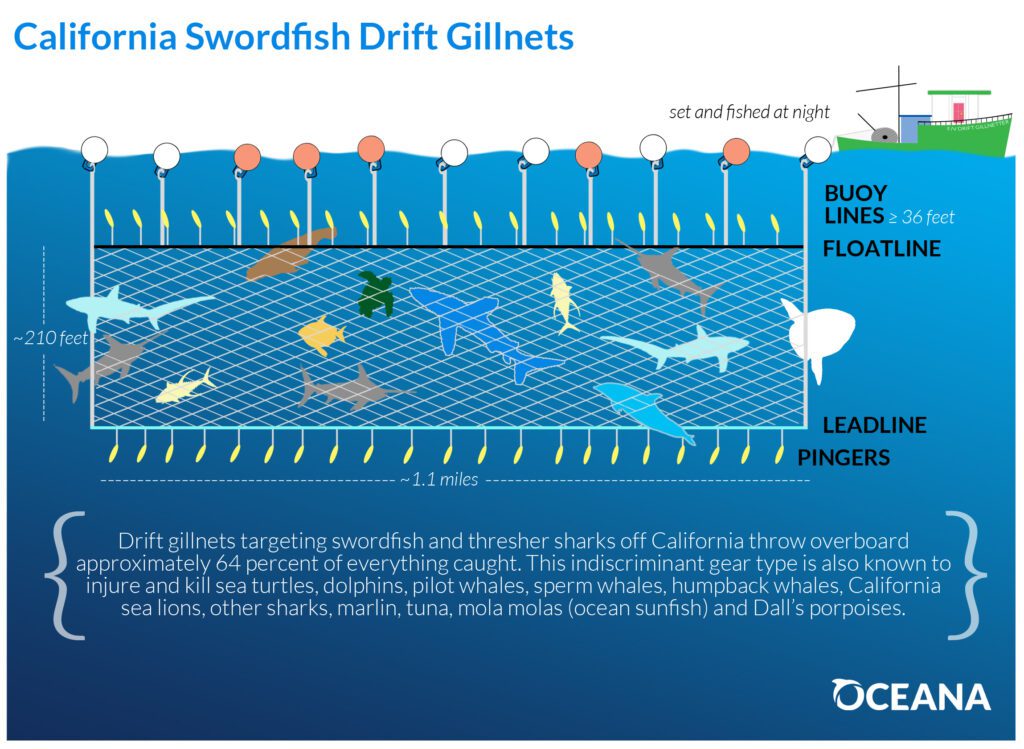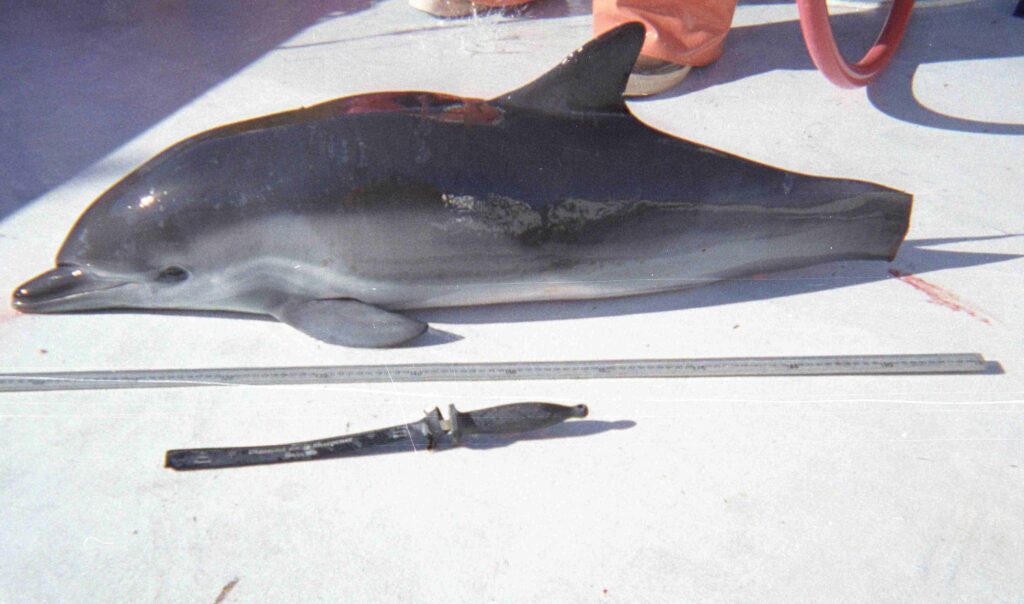March 2, 2023
VICTORY: U.S. phases out destructive and deadly drift gillnets for good
BY: Caroline Mowdy

Earning the nickname “walls of death,” swordfish drift gillnets are notorious for the damage they inflict on marine life. These mile-long, nearly invisible nets are set out at dusk and reach 200 feet below the surface of the ocean, remaining there for up to 12 hours. When the nets are retrieved at dawn, they might have caught a few swordfish, but the nets also intercept non-target species like whales, dolphins, sea turtles, sharks, and more. This “bycatch” is ultimately thrown back to the sea, often dead or dying.
Every year these nets entangle, injure, and kill thousands of other ocean animals. Notably, more dolphins are harmed in the California swordfish drift gillnet fishery than in all other U.S. West Coast and Alaska fisheries combined.
Large-mesh drift gillnets were once a popular, passive fishing gear used around the world, but their destructive impact has prompted many countries to prohibit the practice. Some fisheries in the U.S. have banned the use of this gear for decades, including the Atlantic swordfish fishery. But in federal ocean waters offshore California and Oregon (3 to 200 nautical miles), swordfish drift gillnets are still being used to this day.
THE GOAL
Oceana has long campaigned to remove this destructive gear from U.S. waters. Over time, some measures were implemented to rein in bycatch, like time and area closures to protect endangered sea turtles. But these changes were not enough. Wherever and whenever this gear was used, the bycatch was horrendous. It became clear to Oceana that large-mesh drift gillnets must be prohibited and the swordfish fishery needed to transition to a more sustainable alternative.
THE CAMPAIGN
Oceana campaigned to prohibit the gear on both state and federal levels because the large-mesh drift gillnet swordfish fishery off the coast of California requires both state and federal permits. In 2018, Oceana worked with the California legislature and California Department of Fish and Wildlife to establish a transition program for fishermen to voluntarily surrender their nets and state permits in exchange for financial compensation and incentives to switch to clean fishing gear. The California law also required a $1 million match of funds from a non-state entity.

Oceana and our allies helped advance an innovative, alternative gear to catch swordfish called deep-set buoy gear. It consists of a single vertical line with baited hooks attached that is fished during the day. The gear selectively targets swordfish and reduces bycatch, making the practice more environmentally and economically responsible. An added benefit: since the gear is actively attended by fishers, the swordfish caught are fresher – and a higher value as a result.
In 2019, the Pacific Fishery Management Council approved deep-set buoy gear for targeting swordfish. This took campaigning by Oceana and years of work by researchers and fishermen who modified and tested the gear.
And in 2020, Oceana, with help from supporters, donated the $1 million required by the law to initiate California’s four-year phaseout period for all remaining state drift gillnet permits.
The final campaign push aimed to close the gap between federal and state management by prohibiting drift gillnets in all U.S. waters. In December 2022, Oceana and our allies were successful. Federal legislation was signed to permanently transition out large-mesh drift gillnets.
THE VICTORY
The bipartisan Driftnet Modernization and Bycatch Reduction Act will phase out destructive large-mesh drift gillnets and promote the transition to selective and sustainable fishing techniques. The new law aligns state and federal policy to ban the use of this wasteful gear in all U.S. waters, and all remaining federal permits will be phased out over the next five years.
WHY IT MATTERS
With the California state transition program successfully implemented, roughly 50 miles of large-mesh drift gillnets have already been permanently removed from the Pacific. The nets are being destroyed and recycled into other products, ensuring they will never end up back in the ocean. The federal legislation will further remove an additional 25 miles of drift gillnets, reducing bycatch and saving vulnerable species. Based on data collected by the National Oceanic and Atmospheric Administration (NOAA), Oceana estimates that the transition will save a minimum of 27 whales, 548 dolphins, 333 seals and sea lions, 24 sea turtles, and 70 seabirds over 10 years. Importantly, the state and federal legislation were designed to help fishermen switch to alternate gear that will not only yield higher prices for their catch, but also will give consumers the confidence that their seafood purchase isn’t fraught with deadly consequences.



